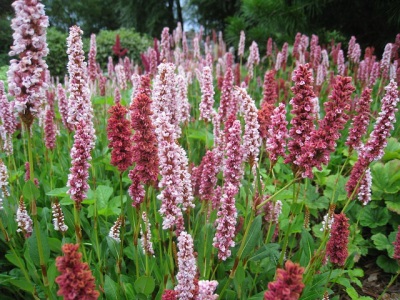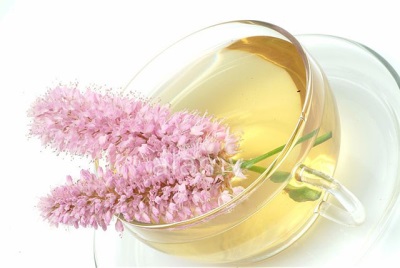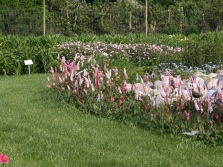Highlander serpentine (large serpentine)

Highlander belongs to the plants of the Buckwheat family, the genus Serpentine. In the people, this herbaceous perennial is called the snake root. The name "cancer necks" is also found.
Appearance
- The snake mountaineer has a straight stem with a small number of branches. Its height can reach 1 meter.
- The root of the serpentine is dark red. It is slightly flattened and arched. The surface is covered with folds, because of which it looks like cancer "necks".
- The leaves are arranged alternately, they have an oblong shape and slightly wavy edges.
- Highlander blooms in May-June with dense pink inflorescences (flowers are small).
- The fruits, which are shiny, smooth, 3-sided brown nuts, ripen by July.

Kinds
The mountaineer has the following types:
- splayed - spherical bushes, height up to 1.2 m;
- related - drought-resistant, blooms for a long time;
- viviparous - narrow leaves, reproduction by bulbs appearing in inflorescences;
- Japanese - the largest (up to 4 m), winters well in a temperate climate;
- veyriha - grows well in loamy fertile soil, height up to 2 m;
- alpine - unpretentious, thermophilic, blooms profusely, height up to 1.5 m;
- baljuan - grows quickly, looks very attractive, freezes easily (while recovering very quickly);
- lingonberry - low, resistant to frost, but needs protection from excess moisture.



Where does it grow
The plant is common in the northern regions. It grows in temperate climates. In Russia, the highlander can be found in Siberia and in the European part of the country.Its thickets are formed on the banks of reservoirs, in floodplain or marshy meadows. Also, the serpentine can be found in forest clearings.

spice making method
The rhizomes of the plant are used for medicinal purposes. Their harvesting is carried out in the fall (in September and October) or in the spring before the branches leave.
The rhizomes are dug up, cleaned from basal leaves and stems, as well as from the ground, washed with cold water, and then dried in a warm room that is ventilated, as well as in the open air or in a dryer with the possibility of artificial heating (this method is preferable, since the rhizomes are dried needed quickly).
It is recommended to harvest rhizomes again in one place after at least 8 years.
The resulting raw material is suitable for 5-6 years.
It is a dark brown rhizomes with transverse folds on the outside. Inside, the roots are pinkish-brown, they have no smell, and the taste is slightly bitter and astringent.

Peculiarities
- The large serpentine is classified as an ornamental plant.
- He is a good honey plant.
- Its rhizome can replace the roots of ratania.
Chemical composition
In rhizomes there is:
- starch - up to 26%
- ascorbic, ellagic, gallic acids
- colorants
- calcium oxalate
- tannins - up to 25%
- ash
- catechins
In the above ground:
- vitamin C
- quercetin and other flavonoids

Beneficial features
The plant has the following effect:
- anti-inflammatory;
- immunocorrective;
- astringent;
- hemostatic;
- soothing;
- wound healing.

Contraindications
Preparations from this plant are not recommended for:
- pregnancy;
- pancreatitis;
- increased sensitivity of the gastrointestinal tract;
- angiocholitis;
- individual intolerance.
Such drugs do not have a toxic effect, but their long-term use can cause constipation.
Application
In cooking
- Young leaves and shoots of the highlander are consumed raw, boiled, dried, and also fermented.
- The leaves of the plant are delicious in salads and soups.
- In the past, the abraded rhizome of the serpentine was added to bread during times of crop failure.
- The plant can be used to make tea.
- The aerial part of the plant can be used as a spicy aromatic additive.
- It can also replace spinach.
Recipes with highlander snake:
Tea
Pour 2 teaspoons into a thermos. spoons of chopped serpentine root and pour 250 ml of boiling water. Infuse for five hours, shaking regularly, and then strain. Drink this tea hot once a day (1 cup).

Highlander root cakes
Rinse the raw materials with cool water, and then soak for a day. Next, dry the roots and grind to flour. It contains up to 10 percent protein and about 30 percent starch. Dough is prepared from such flour and cakes are baked. You can also add the flour obtained in this way to the dough when making ordinary bread.
mountaineer salad
Rinse the green leaves of the knotweed (100 grams) well, then blanch them for five minutes and rinse under cold water. After grinding, add salt and any dressing to taste.

Salad with other herbs
Take 50 grams of burdock, serpentine and nettle leaves. Blanch them for five minutes, then cut and salt. Add a chopped boiled egg to the chopped leaves and season everything with sour cream.
Highlander garnish
To prepare it, you can add the stems and leaves of the coil to any stewed vegetables. They should be blanched first. This side dish is good for fish and meat dishes.
In medicine
For medical purposes, mainly the rhizomes of the plant are used, less often its flowers.
The coil is used:
- Externally with inflammation on the skin, wounds, furunculosis, pain, burns.
- With diseases of the gastrointestinal tract and diarrhea, as an astringent.
- With beriberi (treatment of scurvy) due to the high content of vitamin C.
- As a hemostatic agent for heavy menstruation and other bleeding.
- With cystitis, stones inside the gallbladder, cholecystitis, pharyngitis, peptic ulcer, stomatitis, ear diseases, laryngitis, tumors, vaginitis and other pathologies.

Powders and decoctions are prepared from the plant.
Powder
Recommended for diarrhea, dysentery, bleeding. Taking from 0.5 to 1 gram of powder from the serpentine rhizome, it is mixed with honey and rolled up in a bread crumb. Take this remedy half an hour before meals three times a day.

Infusion of flowers
Used in diseases of the ear. The flowers of the highlander snake (10-20 grams) are poured with 200 ml of boiling water. After 8 hours of infusion in a thermos, the infusion is filtered and taken 3-4 times a day for a tablespoon.
Wine tincture
Shredded dried rhizome (20 grams) is poured with a liter of white wine. After insisting with occasional shaking for eight hours, strain and drink in small portions throughout the day in case of poisoning.
Decoction for oral use
The tool is used in the formation of stones in the bladder or gallbladder. It should be taken at a dose of one glass per day.
To prepare a decoction, 20 grams of crushed rhizome powder should be poured with hot water (one liter), after which the vessel is covered with a lid and boiled for 20 minutes (use a water bath). Strain the broth while still hot, then add water to get the original volume.
Decoction of rhizomes for rinsing
The crushed rhizomes in the amount of a tablespoon are poured with boiling water (a glass). After boiling the mixture over low heat for 5 minutes, it should be filtered and used warm for rinsing with sore throat, gingivitis or stomatitis.
At home
- leather tanning
- Dyeing woolen fabric (for rich black and yellow)
- Ink preparation
- Aromatization of alcoholic beverages (wine, liquor and other drinks)



Varieties
- Superba is a species of snake mountaineer, the differences of which are a bush with a diameter and a height of 0.6 m, light pink large flowers.
- Darjeeling Red is a species of knotweed with dark pink flowers.
- Donald Lowndes is a kind of highlander with pink-red flowers.
- Dimity - a variety with dark green leaves, wine-red stems. Its flowers are white at the beginning of flowering, then turn pink-red, and when they fade, they turn to a rusty brown hue.


cultivation
Rhizomes for growing serpentine are taken in its natural thickets in late autumn or early spring. They are planted in fertile land, cleared of weeds. Such rhizomes give rise to larger and more spectacular plants than natural ones. For growing Knotweed, a damp place is recommended, which may be slightly shaded.



When caring for a plant, you need to weed it and water it if there is a lack of moisture. It is possible to harvest the roots of plants planted in this way in the third year after planting. No need to dig up the whole plant, just cut off half of it. So you will collect raw materials and preserve the beauty.
If you want to grow snake knotweed from seeds, they should be planted in the soil before winter. Seedlings that appear in spring grow rapidly and begin to bloom in two years.











Wow, I didn't know it wasn't recommended during pregnancy.
Good afternoon. I've been using the big mountaineer serpentine almost since birth. My parents used it. I always take it with me on any trip. It helps with diarrhea, bleeding during heavy menstruation.
Class!